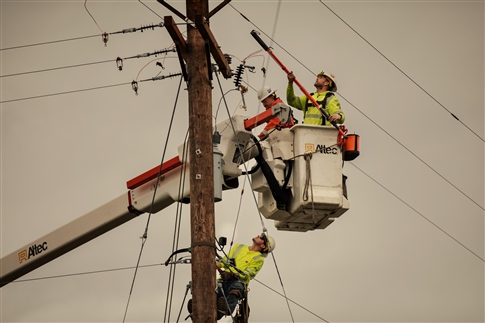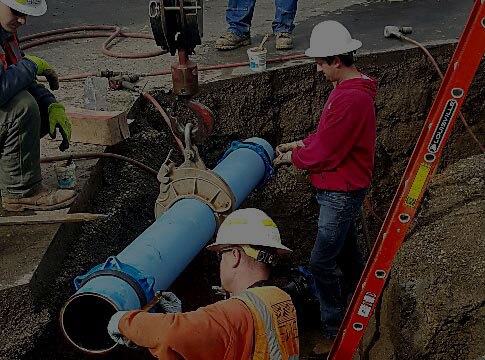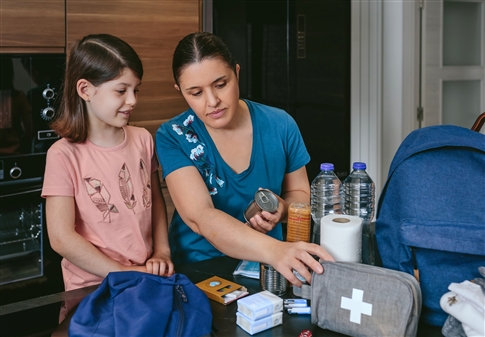Be 2 Weeks Ready
Being prepared for a power outage or water emergency is critical to the health and well-being of your family.
Natural disasters like earthquakes can damage water infrastructure and winter storms can lead to prolonged power outages.
Here are some tips to be prepared for the possibility of a disruption in your utility services.

Getting updates about your power outage
If you are experiencing a power outage, please check our Outage Map to see if it has already been reported.
To report a power outage that does not appear on the map, please call our toll-free outage reporting line at 1-844-484-2300. You must complete all prompts to record your outage.
During large or widespread outages, we will post updates on this website as well as on Facebook and Twitter.
Power Outage MapStaying warm in a power outage
If there is an extended power outage in the middle of winter, you'll need to take steps to keep your home as warm and comfortable as possible.
- Avoid opening and closing exterior doors.
- Set up "camp" in one room, and close off the rest of the house.
- Close interior doors, and hang blankets across passage ways to help retain heat.
- Place rolled up towels at the base of exterior doors.
- Cover the windows with blankets and/or plastic.
- Put blankets, rugs or pillows on the floor to further insulate the room.
- Wear loose layers of clothes.

Common Questions
What do I do if I see a downed power line?
If you see a downed line, assume it is a live power line and call EWEB immediately at 541-685-7000, select option 2 and follow the prompts. If the situation is life-threatening (such as on top of an occupied car or across a street or sidewalk), call 911. There is no way to know whether it is energized, so play it safe and keep your distance—stay at least 50 feet (about the length of two busses) away from the line. Stay away from fences, standing water and debris that is near the line. Puddles and limbs could be electrically charged if the line is still energized.
How can I prepare my home for restoration?
- If you have electric heat, please turn down your thermostats to prevent overloading the distribution system (and causing another outage) when power is restored.
- Keep your fridge & freezer closed as much as possible. During prolonged outages, food will stay frozen about 2 days in a full freezer and 1 day in a half-full freezer.
- Make sure your stove or other appliances with heating elements are turned off. This could create a safety hazard if you are not home when power is restored.
- If you're electronics aren't protected with a surge protector, you may consider unplugging electrical equipment during an outage.
- Leave an inside light and a porch light switched on, so you and EWEB repair crews will know when power has been restored.
I have partial power and/or flickering lights. What should I do?
If you have power, but are experiencing irregularities such as the lights suddenly getting really bright in part of your house and dim in another, or your lights work in one part of your home and not another, you might be experiencing partial power.
If you have power in part of your house, first check your circuit panel to be sure you don't have a tripped breaker.
If your power does not come back on, or if you are experiencing dim or overly bright lights, please turn off the main breaker at your circuit panel. Call us at 1-844-484-2300, press '1' to report a new outage and then press '3' to report your partial power outage. Follow all of the remaining prompts.
Prevent Frozen Pipes
Save yourself the hassle and cost of emergency repairs by locating pipes in areas that have a higher risk for freeze damage. Then take a few simple steps to reduce the risk of burst pipes.
- Wrap pipes located in unheated areas - such as an attic, crawl space or garage - with foam pipe insulation.
- Drain water from underground sprinkler piping and backflow prevention assembly. Wrap the assembly with foam insulation.
- Disconnect and drain garden hoses. If you don't have frost-proof outdoor faucets, install an insulated cover.
Locate your water meter:
- Make sure your customer-side hand valve shuts your water off completely.
During a cold snap:
We suggest that you take a few extra steps when winter temperatures plummet to 20 degrees or less.
- Cover crawl space vents. Remember to uncover the vents as the weather warms.
- Open cabinet doors below sinks located against outside walls. Insulation in the walls may not be thick enough to keep pipes from freezing.
- Turn on a small but steady stream of water at the inside faucet farthest away from where your water supply enters your home. Flowing water does not freeze as quickly as still water.
If your pipes freeze:
You will know that your pipes have frozen if you turn on the tap and no water flows.
- Never use a flame or electric appliance, such as a hair dryer or heating pad, to thaw a frozen pipe.
- You can thaw a frozen pipe by warming towels or blankets in the clothes dryer and then wrapping them around the frozen pipe. Repeat this process until water flows from the tap.
- If your pipe breaks, shut off your water using your whole-house valve or customer-side hand valve at the water meter.
- If you cannot shut the water off, call us at 541-685-7595.
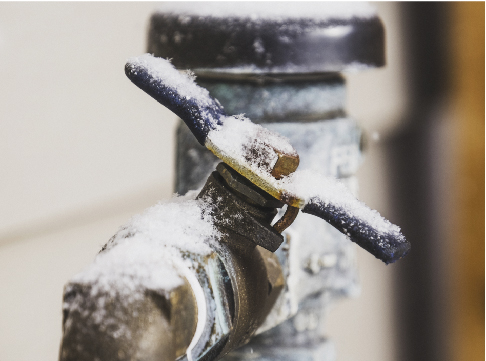
Turning off utilities after a quake
In case of a disaster of any type, it may be necessary to turn off utilities to avoid damage to your home.
Electricity
Unlike gas, turning off the electricity doesn't require any tools. If your lights are flickering or you suspect any damage, locate the electrical circuit box and switch off all the individual circuits. Then turn off the main circuit. If your power goes out, turn off all electric appliances and unplug major electric appliances. This will help prevent damage to the appliances when the power is restored. Learn more about protecting your electronic equipment.
Water
Your water meter is usually located in front of your house near the curb. Often there are two valves that shut off the water: the curb stop (EWEB valve) and the customer hand valve. The curb stop is the valve that shuts the water off to the water meter. The customer hand valve is located directly after the water meter. Here's how to shut off your home's water supply in an emergency.
Don't have a customer hand valve? We offer a rebate to help you install a customer-side hand valve if one is not present. Get more information and the rebate form here.
After an earthquake, don't turn the water back on until you've been notified by EWEB that it is safe to do so.
Gas
If you have gas appliances, you need to know how to keep your home safe before and after an earthquake or other disaster. Visit https://www.nwnatural.com/Residential/Safety/EarthquakePreparedness.
Emergency Water Stations
We are working with community partners to develop an emergency water supply program that includes several permanent distribution sites located throughout the community using groundwater wells, as well as mobile water trailers. As of October 2024, six sites are operational.
Learn more...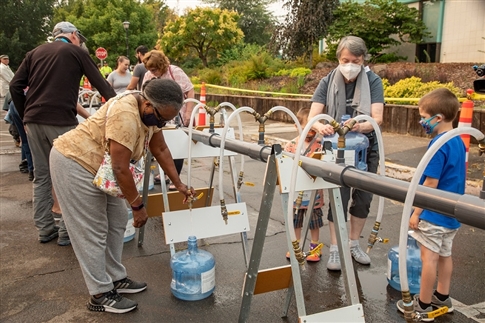
Back-up power sources
Being prepared with a back-up power system in the event of a major disaster or prolonged power outage is an important part of disaster planning, especially for people who use electricity and battery-dependent assistive medical devices such as breathing machines or power wheelchairs. Learn more about our Residential Medical Support Program.
Generating your own power
Backup generators and other backup power options including battery storage systems can help provide peace of mind should such an event occur.
There are two kinds of generators, portable and permanent. Portable generators are intended to provide power to an extension cord which is then plugged directly into an appliance or piece of equipment. Permanent generators are wired directly into the electrical system of your home. Learn more about generator safety.
We want to help our customers increase their safety and resilience in a power outage. EWEB offers a Backup Power Program to assist with the purchase and installation of a backup power system and mechanism to safely power to safely power critical components in a home during an emergency. Backup power systems can include generators or battery storage systems for the purposes of backup power.
Let there be light
Whether a natural disaster or just an unanticipated power outage, having emergency lighting is critical to helping you navigate the darkness. LED flashlights provide super bright light and last for hours. Keep several flashlights at home and keep one in each of your cars. Lightsticks and emergency candles or lanterns can provide low level lighting for extend periods of time. Make sure your emergency kit includes extra batteries.
Stay connected
Smartphones have become a vital tool to receive emergency alerts and warnings, so it's important to make sure you can keep them powered up in an emergency. If the power goes out, preserve battery power by minimizing device use and changing the setting to low power mode or airplane mode. Have an emergency charging option for your phone and other mobile devices.
Safety tips for all generators
- Always follow the guidelines in your operator's manual
- Know how to shut off the generator in case of an emergency
- Never modify the generator in any way
- Never refuel a generator while it is running or hot
- Periodically run the generator to ensure it will start and run properly
Related Programs
Need-to-know information during a power event. Find links to our outage map and don't forget to follow us on social media for the latest news.
If you experience a water outage or water emergency, please call 541-685-7595.

